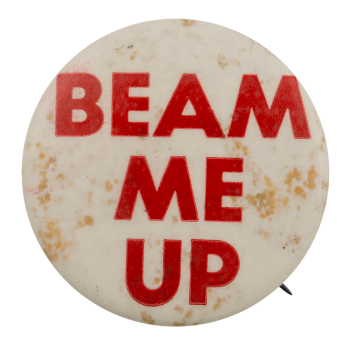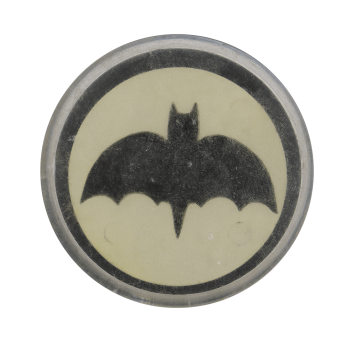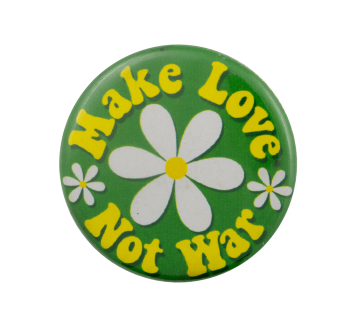| Information |
Text: Be kind to animals printed in red on white background. Graphic: Full color picture of a rat biting a man's hand on white background. I used to have this one. I can't find it. I'll keep looking for it to add more information. If anyone has any information about this button, please share it with me. Google image search hasn't provided any results. Museum Edit (email from a visitor): |
|---|---|
| Button Image |
Grandad's Zoo
| Category | |
|---|---|
| Additional Images | |
| Sub Categories | |
| Text on Button | SOUVENIR OF GRANDAD'S ZOO |
| Image Description | Across the center is a white banner with black text. Above the banner is the image of a horse's head and ox's head. Black text curls around the edge of the button above the horse and ox. Below the white banner is the image of racing horses with the head of a ram and pig on either side. Some fruit and vegetable images are below the ram and pig heads. |
| Back Style | |
| The Shape | |
| Additional Information | Have info on this button? Contact us here. |
| Catalog ID | AD1030 |
Beam Me Up
| Category | |
|---|---|
| Additional Images | |
| Sub Categories | |
| Text on Button | BEAM ME UP |
| Image Description | White background with three lines of large red text. |
| Back Style | |
| The Shape | |
| Additional Information | The phrase "Beam Me Up" is associated with the 1960s science fiction television series Star Trek. In the show, crew members of the U.S.S. Enterprise explore distant planets using teleportation. They rely on the ship's chief engineer Montgomery Scott, or Mr. Scotty, to "Beam them up." However, that exact phrase was never actually said on the show. Over the decades, the phrase has become associated by way of Pop-Cultural Osmosis. The phrase may have first appeared on a bumper sticker stating, "Beam me up, Scotty, there's no intelligent life on this planet." It has become everyday slang for "hit me up" or "text me," as well as a reference to escapism. In 2009, hip-hop artist Nicki Minaj's album was titled “Beam Me Up Scotty” and featured a song by the same name. In 2012, singer P!nk released the single "Beam Me Up" about loss. |
| Sources |
Hanson, K. (2020, Mar 1,). How ‘Beam me up, Scotty’ evolved from technomagic to hip-hop. Medium. https://medium.com/swlh/how-beam-me-up-scotty-evolved-from-technomagic-… |
| Catalog ID | EN0591 |
Bat Symbol
| Category | |
|---|---|
| Additional Images | |
| Sub Categories | |
| Image Description | Black bat silhouette symbol in center. Background is white with a black border inside a silver border. |
| Back Paper / Back Info |
CHINA |
| Back Style | |
| The Shape | |
| Additional Information | The image may be the symbolization of Batman, which originated from DC comics. Batman is one of the world’s most iconic fictional characters. His purpose is to dedicate his life to wage eternal war on the criminals of Gotham City. His alter ego, Bruce Wayne is a playboy billionaire who witnessed the tragic murder of his parents as a child. Since then, he trained himself to become a self-made superhero known as Batman and uses advanced technology to humiliate many armies. Batman is sometimes known as “Dark Knight,” “Caped Crusader,” and “Matches Malone,” and he formed teams consisting of his fellow DC superheroes such as the Justice League, the Outsiders, and Batman, Incorporated. |
| Catalog ID | EN0590 |
George Washington 2
| Category | |
|---|---|
| Additional Images | |
| Sub Categories | |
| Image Description | Yellow background. A black and white portrait of George Washington in an oval frame is in the center. At the top of the frame is perched a bald eagle. On either side of the portrait is a flag banner held up by gold star pins. At the bottom of the portrait is a branch of a plant. |
| The Shape | |
| Additional Information | George Washington was the first president of the United States, and served in the role from 1789 to 1797. He was Commanding General of the Continental Army and a founding father who helped establish the U.S. Constitution and federal government. The American bald eagle with wings spread at the top of the portrait represents the strength and courage of the United States; it became the national bird in 1782. The laurel garland under the image represents victory and honor. In ancient Rome, a laurel wreath crowned a successful commander. The flag of the newly formed United States surrounds the portrait. A eulogy for George Washington declared, “First in war, first in peace, and first in the hearts of his countrymen.” His image is found in art, national monuments, currency, and souvenirs. |
| Sources |
Mount Vernon. (2021). Biography. https://www.mountvernon.org/george-washington/biography/ |
| Catalog ID | PO1151 |
Dutch Treated
| Category | |
|---|---|
| Additional Images | |
| Sub Categories | |
| Text on Button | I like being "Dutch Treated" DUTCH PANTRY |
| Image Description | Red background with white text. At the very bottom is a logo in the shape of the blade of a windmill with small white text next to it. |
| Back Style | |
| The Shape | |
| Additional Information | The first Dutch Pantry Family Restaurant opened in 1945 along U.S 11 near Selinsgrove, Pennsylvania. The name Dutch Pantry was meant to suggest that every Pennsylvania Dutch home contained a pantry stocked with good food. The restaurant grew into a chain expanding across Pennsylvania and a few locations in Florida. The Dutch Pantry featured a standard design that reflected the food and atmosphere of Pennsylvania Dutch country. Buildings were colorful with roofs decorated in red and white tiles and a sign in the shape of a windmill. The interior contained two rustic dining rooms and a county store. They were also franchises of Kentucky Fried Chicken and featured the Colonel's chicken on the menu. In the 1970s, ownership changed with plans for the expansion of 300 restaurants. Unfortunately, by 1983, the chain was in steady decline, and development goals were never met. By the 2000s, only a couple of Dutch Pantry Family Restaurants remained. |
| Sources |
Highway Host. (n.d.) Dutch pantry. http://www.highwayhost.org/DutchPantry/dutchpantry1.htm |
| Catalog ID | AD1028 |
Cornerstone Laying
| Category | |
|---|---|
| Additional Images | |
| Sub Categories | |
| Text on Button | CORNERSTONE LAYING NOV. 3, 1929 |
| Image Description | Tan background with dark blue border. An image of a building is in the center with three circular portraits of men below it. Black text curls around top edge of button above the building. |
| Back Paper / Back Info |
THE WHITEHEAD & HOAG CO. NEWARK, N.J. |
| Back Style | |
| The Shape | |
| Additional Information | A cornerstone is traditionally the first stone laid for the building’s structure, and it reminds people of the geographical location of the building. Cornerstones became a symbol of a new era by indicating prosperity and opportunity. Their pieces became collected from the historical interest of marking previously standing buildings. The cornerstone laying is often known as a ceremonial event rather than the first step of the construction process. During the ceremony, the cornerstone is laid with a ceremonial trowel by a well-known member of the institution or a local celebrity. This building appears to be the early architectural design of the Pontifical College Josephinum, with its cornerstone laid in Worthington, Ohio 1929, a week before stock markets crashed bringing the sign of the Great Depression. The Josephinum was originally a German school for priests focusing on serving Catholic immigrant families. But as the demand for German-speaking priests declined, the Josephinum shifted its attention to prepare men for Church services within the United States and around the world. The portrait in the middle appears to be a photo of Monsignor Joseph Jessing, who is the founder of the Josephinum. The other two portraits are unknown at this time. Have info on this button? Contact us here. |
| Sources |
NewStudio. (2019). Architectural cornerstones: The meaning, history, and intent. https://www.newstudioarchitecture.com/newstudio-blog/architectural-cornerstones Ohio Memory. (2016). Cornerstone laying ceremonies and the buildings that shape us. https://ohiomemory.ohiohistory.org/archives/2819 Pontifical College Josephinum. (n.d.). Mission and history. Retrieved June 3, 2021, from https://www.pcj.edu/mission |
| Catalog ID | EV0931 |
Re-elect Cripps Auditor
| Category | |
|---|---|
| Additional Images | |
| Text on Button | RE-ELECT CRIPPS AUDITOR |
| Image Description | Cream colored background with three lines of red text. The first and last line of text are medium sized, while the second central line of text is large. |
| Back Style | |
| The Shape | |
| Additional Information | Dover native George Warren Cripps (1916-1983) served three terms as Delaware’s State Auditor from 1966-1973 but lost his re-election campaign of 1972. Cripps, a Republican, also unsuccessfully ran for the Delaware State Senate in 1974, and for Delaware Governor in 1976. Prior to serving as auditor, Cripps was a successful businessman, running Capitol Glass & Mirror Inc and was President of the Greater Dover Chamber of Commerce from 1961-1963. |
| Sources |
Horgan, D. (1983). Dover Politician G.W. Cripps Dies. The Morning News, pp. 1, 4. Retrieved 6 July 2021, from https://www.newspapers.com/image/155053455/?terms=Cripps&match=1. |
| Catalog ID | PO1150 |
Sullivan Attorney General
| Category | |
|---|---|
| Additional Images | |
| Text on Button | Sullivan Attorney General |
| Image Description | Cream background. The first line of text is green with a black border, the second two lines of text are black. |
| Back Style | |
| The Shape | |
| Additional Information | |
| Catalog ID | PO1149 |
Flower Make Love Not War
| Category | |
|---|---|
| Additional Images | |
| Sub Categories | |
| Text on Button | Make Love Not War |
| Image Description | Green background with flower in the center with six white petals with yellow center. Yellow text curls around top and bottom, with smaller white flowers on left and right between the two lines of text on the center edge of the button. |
| Back Style | |
| The Shape | |
| Additional Information | The phrase “Make Love, Not War” was a popular protest chant in the 1960s as thousands of Americans marched against United States involvement in the Vietnam War. Origins of the phrase cannot be certain, but research has shown two possibilities: Penelope Rosemont or Diane Newell Meyer. Penelope Rosemont believes the origin lies with her and the buttons her bookshop made for the Chicago Mother’s Day Peace March in May 1965. But a full month earlier, Diane Newell Meyer was a student at the University of Oregon and remembers writing the phrase on an envelope and pinning it to her shirt before going to an anti-Vietnam War demonstration in April 1965. Her picture was taken and posted in a May 9th (1965) article written by Mitchell Levitas for the New York Times Magazine. |
| Sources |
Creative Review. 2021. History of the Make Love Not War slogan - Creative Review. [online] Available at: <https://www.creativereview.co.uk/make-love-not-war-slogan/> [Accessed 11 May 2021]. Fattig, P., 2010. The SIXTIES: Make Love, Not War! coined in Ashland. [online] Web.archive.org. Available at: <https://web.archive.org/web/20140226162426/http://sixties-l.blogspot.co…; [Accessed 11 May 2021]. Rosemont, P., 2015. Make Love; Not War! - Issue 394, Summer 2015 - Fifth Estate Magazine. [online] Fifthestate.org. Available at: <https://www.fifthestate.org/archive/394-summer-2015/make-love-not-war/&…; [Accessed 11 May 2021]. |
| Catalog ID | CA0843 |


















